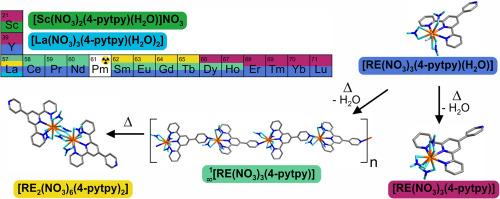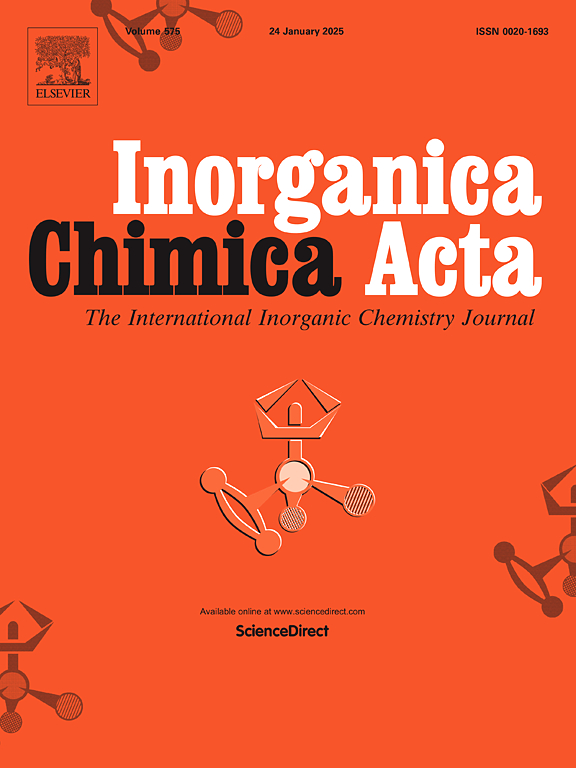Synthesis of rare earth nitrate complexes with 4′-pyridin-4-yl-terpyridine and their solid-state transformation to coordination polymers
IF 3.2
3区 化学
Q2 CHEMISTRY, INORGANIC & NUCLEAR
引用次数: 0
Abstract
The interaction of the series of trivalent rare earth (RE) nitrates with 4′-(pyridin-4-yl)-2,2′:6′,2″-terpyridine (4-pytpy) was investigated. In direct reaction between RE(NO3)3·nH2O with 4-pytpy, both, a series of isotypic complexes [RE(NO3)3(4-pytpy)(H2O)] (1a-RE with CN 10 and 1b-RE with CN 9) and the structurally individual complexes [La(NO3)3(4-pytpy)(H2O)2] (2) and [Sc(NO3)2(4-pytpy)(H2O)]NO3 (3) were obtained. The thermal stability of the phases was investigated using simultaneous differential thermal analysis and thermogravimetry (DTA/TG or STA) as well as high-temperature powder X-ray diffraction analysis (HT-PXRD). Coordinated water can be removed from complexes 1–3, resulting in the formation of coordination polymers 1∞[RE(NO3)3(4-pytpy)] (4-RE) for early and middle lanthanides as well as [RE(NO3)3(4-pytpy)] (5-RE) for late lanthanides, yttrium, and scandium. At elevated temperatures (150–370 °C), the polymeric structure 4-RE with a connection via organic linker dissociates, and a series of dimers [RE2(NO3)6(4-pytpy)2] (6-RE) bridged via nitrates are formed; the temperature of this transition reduces along the lanthanide series. In general, the accessibility of the phases and solid-state transformations depends on the ionic radius of the trivalent rare earth element. Photophysical properties of Eu3+ and Tb3+ were determined in the solid state. The absolute photoluminescence quantum yield (PLQY) of polymorphs presented here depends on the packing, which determines the ligand energy levels. Highlight is 1∞[Eu(NO3)3(4-pytpy)] (4-Eu) with the PLQY of 79.3(9) %. In addition to single-crystal X-ray diffraction (SCXRD), 3D electron diffraction analysis (3D-ED) was used for the determination of crystal structures.

硝酸稀土与4′-吡啶-4-基三吡啶配合物的合成及其固相转化为配位聚合物
研究了一系列三价稀土硝酸盐与4′-(吡啶-4-酰基)-2,2′:6′,2″-三吡啶(4-pytpy)的相互作用。RE(NO3)3·nH2O与4-pytpy直接反应得到了一系列同型配合物[RE(NO3)3(4-pytpy)(H2O)] (1a-RE与cn10和1b-RE与cn9)和结构独立的配合物[La(NO3)3(4-pytpy)(H2O)2](2)和[Sc(NO3)2(4-pytpy)(H2O)]NO3(3))。采用同步差热分析和热重分析(DTA/TG或STA)以及高温粉末x射线衍射分析(HT-PXRD)研究了相的热稳定性。配合物1 - 3中的配位水可以被去除,形成早期和中期镧系元素的配位聚合物1∞[RE(NO3)3(4-pytpy)] (4-RE),晚期镧系元素、钇和钪的配位聚合物[RE(NO3)3(4-pytpy)] (5-RE)。在高温下(150 ~ 370℃),通过有机连接剂连接的聚合物结构4-RE解离,形成一系列通过硝酸盐桥接的二聚体[RE2(NO3)6(4-pytpy)2] (6- re);这种转变的温度沿着镧系元素系列降低。一般来说,相的可及性和固态转变取决于三价稀土元素的离子半径。测定了Eu3+和Tb3+在固态下的光物理性质。本文提出的多晶的绝对光致发光量子产率(PLQY)取决于包装,这决定了配体的能级。高亮部分为1∞[Eu(NO3)3(4-pytpy)] (4-Eu), PLQY为79.3%(9)%。除了单晶x射线衍射(SCXRD)外,还使用3D电子衍射分析(3D- ed)来确定晶体结构。
本文章由计算机程序翻译,如有差异,请以英文原文为准。
求助全文
约1分钟内获得全文
求助全文
来源期刊

Inorganica Chimica Acta
化学-无机化学与核化学
CiteScore
6.00
自引率
3.60%
发文量
440
审稿时长
35 days
期刊介绍:
Inorganica Chimica Acta is an established international forum for all aspects of advanced Inorganic Chemistry. Original papers of high scientific level and interest are published in the form of Articles and Reviews.
Topics covered include:
• chemistry of the main group elements and the d- and f-block metals, including the synthesis, characterization and reactivity of coordination, organometallic, biomimetic, supramolecular coordination compounds, including associated computational studies;
• synthesis, physico-chemical properties, applications of molecule-based nano-scaled clusters and nanomaterials designed using the principles of coordination chemistry, as well as coordination polymers (CPs), metal-organic frameworks (MOFs), metal-organic polyhedra (MPOs);
• reaction mechanisms and physico-chemical investigations computational studies of metalloenzymes and their models;
• applications of inorganic compounds, metallodrugs and molecule-based materials.
Papers composed primarily of structural reports will typically not be considered for publication.
 求助内容:
求助内容: 应助结果提醒方式:
应助结果提醒方式:


